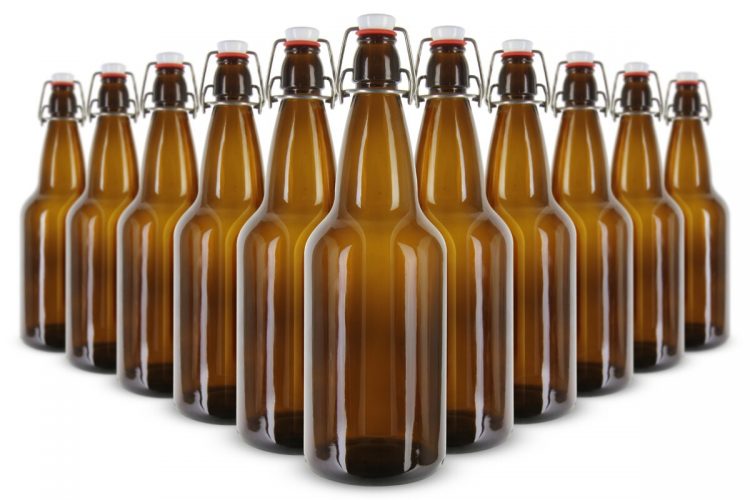Now that your beer is fully fermented and ready for the bottle, you don’t want to mess things up at the last minute. The main risk at this stage is introducing bacteria and sediments to your bottled beer so you need to be mindful about how you go about the process.
It would also be great if you could bottle the beer with as little mess and stress as possible, and finish your brew on a high note. We have created this step-by-step guide to ensure that the final step in your homebrew goes seamlessly.
How to Bottle Beer in 9 Steps
What you’ll need:
- Bottling bucket
- Beer bottles (about 48, 12-oz bottles for a 5-gallon batch)
- Bottle caps
- Bottlebrush
- Auto-siphon/racking cane/bottle filler
- Tubing
- Hose clamp
- Bottle capper
- Measuring cup
- Priming sugar
1. Prepare All Your Bottling Equipment
Collect all your bottling equipment within easy reach and make sure you have everything you need for the entire process. Most spills and accidents happen when your attention is diverted while bottling.
You will need two cases or 48 12-oz bottles for a 5-gallon batch. This is also a good time to remove any labels from your bottles and inspect old bottles for mold, dirt, or other deposits and scrub with a bottlebrush if required.
2. Sanitize all the Bottling Equipment
Carefully sanitize everything that will come into contact with your beer including all tubes, bottles, and bottle caps. Be sure to run sanitizer through all your tubing as well as sanitizing the outside of the tubing.
Turn your bottles upside-down in your dish washer to drain the sanitizer when you are finished.
3. Prepare the Priming Sugar
Priming sugar carbonates your beer. Now, your beer created a lot of carbon dioxide during fermentation as the yeast consumed the sugars but all this CO2 had to be allowed to escape through the airlock to avoid an explosion.
The sill active yeast in your final brew needs to consume more sugar, in this case priming sugar, to create that desirable fizz we associate with beer.
For a 5-gallon batch, mix in ¾ cup of priming sugar with a pint of water and bring the mixture to a boil. Stir the mixture to ensure that the sugar dissolves completely in the water.
Follow your recipe for the exact ratio of water and priming sugar.
Boil the water for roughly 5 to 10 minutes to avoid burning the sugar. Cover the solution and allow it to cool to room temperature.
4. Check You Final Gravity Reading
As your priming sugar solution cools, now is a good time to check the final alcohol content of your beer.
Use your auto-siphon or whichever tool you use to siphon your beer and to take a small sample of the brew. Pour the beer into the hydrometer flask being careful not to fill it beyond the marked line.
Insert the hydrometer and wait for it to stop bobbing before taking the final gravity reading. Use your original gravity reading and final gravity reading to calculate your alcohol by volume (ABV).
To calculate the alcohol content of your beer, take your Original Gravity (OG) and subtract that from the Final Gravity (FG). Multiply the result by 131.25 to get the approximate alcohol percentage.
Formula: (FG – OG) x 131.25 = ABV%
5. Siphon Your Beer into the Priming Solution
Pour your priming sugar solution into your bottling bucket. Make sure that the bottling bucket is the same size as your fermentation bucket to avoid overflow and other such mishaps.
Have your fermentation bucket sitting at a height and your bottling bucket lower than the fermentation bucket to help with the suction. Gravity will take care of the flow of the beer once you get suction.

Ensure that the end of your auto-siphon or racking cane in the fermentation bucket or vessel doesn’t touch the bottom of the container. This ensures that you do not suck up any sediment.
The other end of the tube in the bottling bucket should sit at the bottom of the bucket. The idea here is that the beer should transfer to the bottling bucket with as little disturbance and splashing as possible to avoid mixing in oxygen with your brew.
Now you can begin to siphon the beer into the bottling bucket. Having the tube at the bottom of the bucket will create a swirling motion as the brew pours in and that will mix the priming sugar and beer thoroughly.
6. Prepare Your Bottles
Keep your bottles close to the bottling tube and ready for the bottling.
Again, you want the bottling bucket higher than the bottles like you did while moving the fermented beer into the bottling bucket. Get ready to bottle your own beer.
7. Fill Your Beer Bottles
Insert the auto-siphon in the bottling bucket with the other end of the tube in a beer bottle. Pump the device a few times to activate the siphon. Close the tube with your hose clump as soon as the beer begins to flow.
Take the tube out of the bottle, insert the bottle filler, and place it back into the bottle. Press the tip of the bottle filler against the bottom of the bottle, loosen the hose clamp, and the beer should begin to flow into the bottle. You may need to pump the siphon if nothing is happening.
Simply lift the bottle filler from the bottom of the bottle to stop the beer flow. You want the beer roughly halfway up the neck of the bottle to allow headroom for carbonation.
You can use your hose clamp to regulate the beer flow if you do not have a bottle filler but think about investing in one. It makes the entire process a lot easier.
Repeat the process until you have filled all your bottles.
8. Cap the Bottles
You may want an extra pair of hands to cap the bottles while you fill them.

Place the bottle cap on the top of the bottle and the bottle capper over it. Push both handles firmly in a downward motion to secure the bottle cap.
Repeat the process until you have capped all your bottles.
9. Store Your Beer
Store your beer at around 65-75°F and away from direct sunlight. The bottled beer should take roughly two weeks to carbonate. Don’t be surprised if you see a think layer of yeast on the bottom of the bottle; this is perfectly normal.
Final Thoughts on Bottling Beer at Home
You may be impatient about drinking your bottled beer but wait at least two weeks for the brew to carbonate properly. You may see a beer that is partially carbonated or the bubbles don’t last long if you open the beer too soon. The beer flavor will also be off since the brew requires time for the flavors to balance out and meld.
Once it is time to drink, pour the beer slowly and carefully to avoid getting yeast into your glass. You may want to leave in the last quarter-inch of beer in your bottle for good measure.
Finally, rinse out your bottles immediately after use to make it easier to clean and sanitize them the next time you are ready to bottle your own beer again.


Leave a Reply